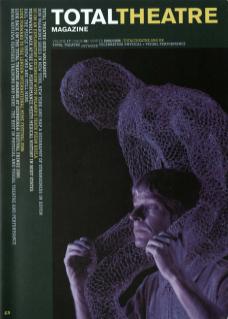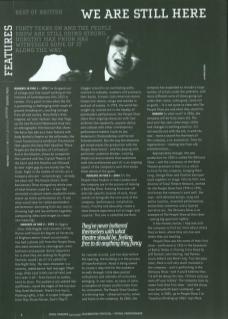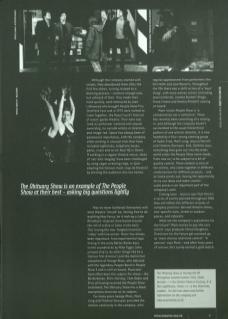Moments in Time 1 – 1976
I've dropped out of college and find myself working at the Institute of Contemporary Arts (ICA) in London. It's a point in time when the ICA is presenting a challenging mish-mash of ground-breaking art, courting outrage from all and sundry. Mary Kelly's dirty nappies; an 'anti-fashion' day that flags up the new McLaren/Westwood shop Sex; an ethnographic film festival that shows the Katie Oxo ads as a main feature with Andy Warhol's Empire as the ad breaks; the Coum Transmissions exhibition, Prostitution, that sparks the Daily Mail headline 'These People are the Wreckers of Civilization'. And in the theatre, shows by companies like Lumiere and Son, Crystal Theatre of the Saint and Hot Peaches are followed by late-night gigs by new bands like The Clash. Right in the middle of all this are a company who are – astonishingly – already ten years old. The People Show's Tenth Anniversary Show changed my whole view of what theatre could be – it was like animated sculpture meets vaudeville meets stand-up meets performance art. It was what would later be called postmodern performance: borrowing from any source, throwing high and low artforms together, juxtaposing ideas and images to create new meanings
Moments in Time 2 – 1993
Liz Aggiss – Diva, Wild Wiggler and convener of the Dance with Visual Art degree at University of Brighton where I teach occasionally – has had a phone call from the People Show, who want someone to choreograph some ballroom and popular dance sequences for a show they are making for Brighton Festival; would I do it? It's called For One Night Only. The main character is a smarmy, jaded dance-hall manager (Mark Long, often cast in this sort of role) and he's seen it all – from foxtrot to samba, twist to disco. The audience are seated like wallflowers round the edges of the luscious Ship Hotel Ballroom. There's live music, flashing lights, a bar. A couple (refugees from They Shoot Horses, Don't They?) stagger around in on everlasting waltz, covered in cobwebs, numbers still pinned to their backs. A manic Latin American dance troupe line-dance, conga and mambo in and out of scenes. In 1993, the world has caught up, and we are in the heyday of postmodern performance: the People Show share their ongoing obsession with 'low' artforms like vaudeville, popular dance and cabaret with other contemporary performance makers (such as Lea Anderson's Cholmondeleys and Forced Entertainment). But the way the elements get mixed marks the production with the People Show brand – and the playing with performer-audience divides, creating theatrical environments that audiences walk into and become part of, is an ongoing aspect of the company's work that keeps them ahead of the game.
Moments in Time 3 – 2004
It's the People Show Studios in East London and the company are in the process of making a Building Show. Evolving from one-off and site-specific strands of work, these events sit alongside the core work of the company: 'performance, installation, music, frivolity and absurdity create a total theatre experience full of magic and surprise'. This one is called We Are Here.
As I wander around, just two days before the opening, the building is in the process of transformation. Wood is being sawed to create a labyrinth for the audience to walk through; little dens pasted with photos and cabinets of curiosities emerging. In one room, an oasis of calm, a saxophonist teases soulful notes from his instrument. The People Show Studios is a thriving hub – rehearsal rooms, venue and home to the company. By 2004, the company has expanded to include a large number of artists under the umbrella, with many different sorts of shows going out under their name, some good, some not so good... It is not quite so clear who The People Show are and what they stand for.
Rebirth
So what next? In 2006, the company will be forty years old. The past year has seen some major shifts and changes in working practice. It's not exactly out with the old, in with the new – more a search for the heart of the company, a re-evaluation. Time for regeneration – making new from old, transformation...
Appropriately enough, the new production for 2005 is called The Obituary Show – and the consensus at the Bush Theatre premiere is that it is a return to form for the company, bringing Mark Long, George Khan and Chahine Yavroyan back together on stage. Felicity Hall, now director of Total Theatre Network, worked for the People Show from 1994 to 1996, and knows the company's work well. She says: 'with detailed design, song and dance routines, ensemble performances, melancholy sweetness and a layered narrative arc, The Obituary Show is an example of The People Show at their best – asking big questions lightly’.
A few months earlier, I had met with the company to find out more about where they've been, where they are now and where they are heading...
People Show was the name of their first show – performed in 1966 in the basement of Better Books in Charing Cross Road by Jeff Nuttall, John Darling, Syd Palmer. Laura Gilbert and Mark Long. Four decades later, Mark is still very much involved in the company – and is performing in The Obituary Show: 'and if you'd told me then I'd still be doing this now, I'd have said you were off your trolley'. The company took its name from that first show – and the shows have henceforth been numbered – we are now, in 2005, up to People Show 114. ‘Saved us thinking up titles,' says Mark.
Although the company started with scripts, they abandoned them after the first few shows, turning instead to a devising process – common enough now, but unheard of then. They made their mark quickly, were embraced by Joan Littlewood who brought People Show 9 to Stratford East and in 1970 were invited to Come Together, the Royal Court's festival of avant-garde theatre. Their work was (and is) performer-centred, with shared ownership, no outside writers or directors, and image-led. Space has always been of paramount importance, with the company often working in unusual sites that have included nightclubs, telephone boxes, parks, rivers and an ex-Nazi HQ in Ghent. If working in a regular theatre venue, ideas of 'set' and 'staging' have been challenged by using cages or boxing rings, or (pre-empting the famous Shunt coup de théâtre) by dividing the audience into two halves.
They've never bothered themselves with what theatre 'should’ be, feeling free to do anything they fancy, be it making a Luke Rhinehart-inspired show based around the roll of a dice or (also in the early 70s) mixing the newfangled invention 'video' with live action. Music has always been important: from experimental tape mixing in the early Better Books days to the soundtracks by Mike Figgis (who jumped ship to do other things like be a famous film director) and the distinctive saxophone of George Khan, who debuted with the legendary People Band in People Show 3 and is still on board. Musicians have often been the subject for shows – Bix Beiderbecke, Billie Holiday, Chet Baker and Elvis all having received the People Show treatment; The Obituary Show has a dead anonymous musician as its subject.
For many years George Khan, Mark Long and Chahine Yavroyan provided the artistic continuity in the company, with regular appearances from performers like Emil Wolk and Jose Navarro. Throughout the 90s there was a shift to less of a 'boys’ thing', with more women artists (including Jessica Worrall, Josette Bushell-Mingo, Fiona Creese and Amelia Pimlott) coming on board.
Mark insists People Show is 'a collaboration not a collective'. There has recently been something of a reining in, and although the company haven't succumbed to the usual hierarchical pattern of one artistic director, it is now headed by a four-strong steering group of Sadie Cook, Mark Long, Jessica Worrall and Chahine Yavroyan. And, Chahine says, everything that goes out into the wider world under the People Show name needs, from now on, to be subject to a bit of quality control. There remains a core of ten artists, who come together in different combinations for different projects – and as Sadie points out, having the opportunity to try out ideas and make smaller-scale pieces is an important part of the company's work.
Coming soon – Jessica says that there's a series of events planned throughout 2006 that will reflect the different strands of company practice: devised theatre shows, site-specific work, street or outdoor pieces, and cabarets.
What are the company's aspirations for the future? 'More money to pay the core artists,' says producer Emma Haughton. Directions for the future get summed up as 'more choices and more control'. 'A pension,’ says Mark – and after forty years of service, he's surely earned a gold watch.
The Obituary Show is touring the UK throughout outumn/winter 2005. Dates include: 1-5 Nov Bristol Tobacco Factory: 8-9 Nov Lighthouse, Poole; 12-13 Nov Riverside, London. For full tour dates and further information on the company see www.peopleshow.co.uk


